AMD released its RX 400 series graphics cards last year, and while they couldn't match the performance of Nvidia’s high-end 10-series GPUs, they arguably offered more bang for the buck. AMD's new 500 series video cards are built on the same underlying Polaris microarchitecture, but they have been refined through a more mature 14nm manufacturing process that allows them to run a bit faster.
The RX 580 leads the charge in performance this time around and supplants AMD's RX 480, which the company released last year. Alongside that, the company sent us a RX 570 to test. This card replaces AMD's RX 470, which came out last August. Like the 400 series before it, the RX 580 and RX 570 still target mainstream users with starting prices at $199 and $169, respectively.
AMD asserts that the RX 580 is competitive with Nvidia's $299 GeForce GTX 1060 and that an overclocked RX 570 is on par with the company's $240 RX 480. We'll test those claims in our review.
AMD Radeon Specs
| AMD Radeon RX 580 | AMD Radeon RX 570 | AMD Radeon RX 480 | AMD Radeon RX 470 | AMD Radeon RX 460 | |
| Stream Processors | 2304 | 2048 | 2304 | 2048 | 896 |
| Texture Units | 144 | 128 | 144 | 128 | 56 |
| ROPs | 32 | 32 | 32 | 32 | 16 |
| Core Clock | 1257MHz | 1168MHz | 1120MHz | 926MHz | 1090MHz |
| Boost Clock | 1340MHz | 1244MHz | 1266 MHz | 1206MHz | 1220MHz |
| Memory Clock | 8Gbps GDDR5 | 7Gbps | 7/8Gbps GDDR5 | 7Gbps | 7Gbps |
| Memory Bus Width | 256-bit | 256-bit | 256-bit | 256-bit | 128-bit |
| VRAM | 8GB | 4GB | 4/8 GB | 4GB GDDR5 | 4GB GDDR5 |
| Transistor Count | 5.7B | 5.7B | 5.7B | 5.7B | 3B |
| Teraflops | 6.17 | 5.1 | 5.8 | 4.9 | 2.2 |
| TDP | 185W | 150W | 150W | 120W | 75W |
| Manufacturing Process | 14nm FinFet | 14nm FinFet | 14nm FinFet | 14nm | 14nm |
| Architecture | GCN | GCN | GCN | GCN 2.0 | GCN 2.0 |
| GPU | Polaris 20 | Polaris 20 | Polaris 10 | Polaris 11 | Polaris 11 |
| Launch Date | 4/18/17 | 4/18/17 | 06/29/16 | 8/16 | 8/16 |
| Launch Price | $199/$229 | $169 | $200/$240 | $199.99 | $139.99 |
As you can see from the spec chart above, the RX 580 is very similar to the RX 480 before it. It features the same amount of stream processors, compute units, and video RAM. Its biggest advantage is that it offers faster core and boost clocks. With its 1340MHz boost frequency, the RX 580 is 74MHz (six percent) faster than the RX 480. This makes the RX 580 a 6.17 teraflop GPU.
On the downside, with a 185-watt TDP, the RX 580 consumes up to 35 more watts than the RX 480. This makes it slightly more power-hungry than Nvidia's high-end GTX 1080. AMD recommends at least a 500-watt PSU for the card.
The RX 570 has also received a frequency bump over the RX 470. Its 1244MHz boost speed makes it three percent faster than its predecessor. In addition, it's more power-hungry than the RX 470 and carries a 150 watt TDP, which is the same as the RX 480.
Design
AMD usually sends reference boards for reviews, but this time around, the company sent us an RX 580 from Sapphire and an RX 570 from Asus.
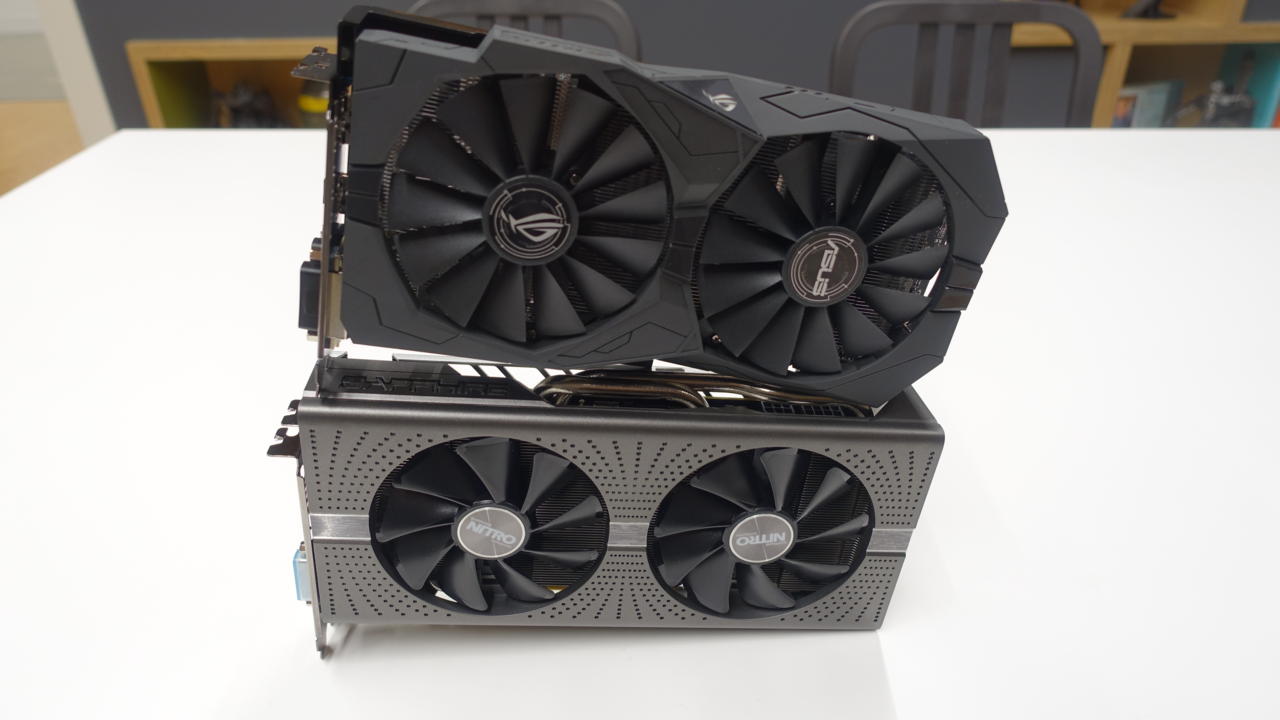
The Sapphire Nitro+ Radeon RX 580 Limited Edition card that we received is overclocked, but at $275, it's also $46 more than the card's starting price. Sapphire's Limited Edition variant comes with 8GB of video RAM and sports two fans in a "gun metal" finish. The GPU is overclocked by 110MHz, going from a boost speed of 1340MHz to 1450MHz. It features two DisplayPort connections, two HDMI ports, and a DVI port. In terms of power, the card requires a 500-watt or greater power supply that has an eight and six-pin power connector.
The Asus Strix RX 570 is also overclocked, and at $189, it retails for $20 more than the GPU's base price. The Strix card sports two fans and offers a modest 34MHz overclock over 1244MHz baseline models. The card also offers RGB lighting. In terms of connections, the Strix RX 570 has two DVI ports, an HDMI port, and a DisplayPort connection.
Both cards support features like VR, FreeSync, HDR, and 4K streaming.
Benchmarks
To ensure benchmarking consistency, I'm using the same system that I used to review the 1080 Ti, 1080, 1070, 1060, and RX 480. It's equipped with an Intel Core i7-5930K Haswell-E CPU clocked at 3.9GHz, coupled with 16GB of DDR4 RAM clocked at 2133MHz running in quad-channel mode.
To provide the widest data set possible, I'm going to test the card against all the aforementioned graphics cards using the same suite of synthetic, VR, and game benchmarks. These tests encompass three resolutions (1080p, 1440p, and 4K). I also ran each benchmark at their respective max settings to really put the GPUs through their paces.
1080p Benchmarks
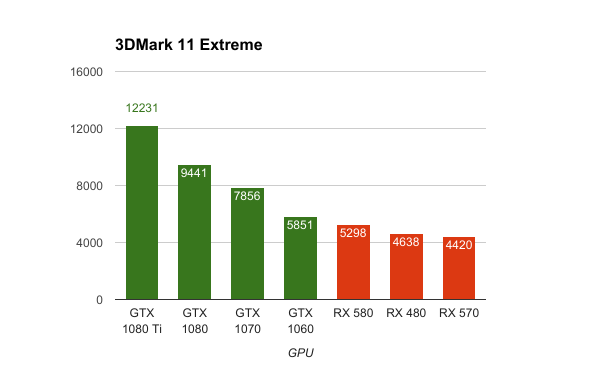
3DMark 11 is a synthetic graphics benchmark that produces a score based on a GPU's DirectX 11 performance; the higher the score, the better the result. Sapphire's RX 580 manages to beat AMD's reference RX 480 here by 14 percent, but falls nine percent short of Nvidia's reference GTX 1060. The Strix RX 570 brings up the rear and gets within five percent of the RX 480.
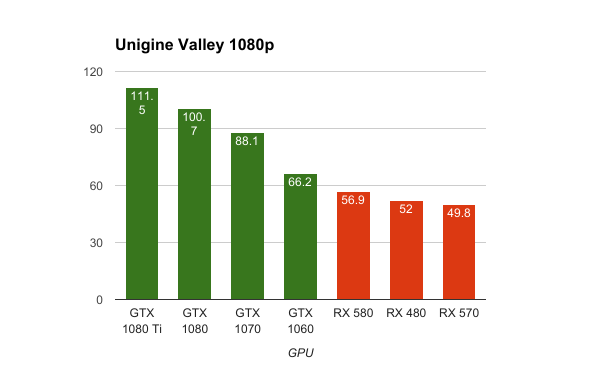
Unigine Valley is another synthetic graphics benchmark. Instead of providing a score, however, it provides average frame rate data. This test echoes the results of the 3DMark 11 benchmark above with a similar performance spread.
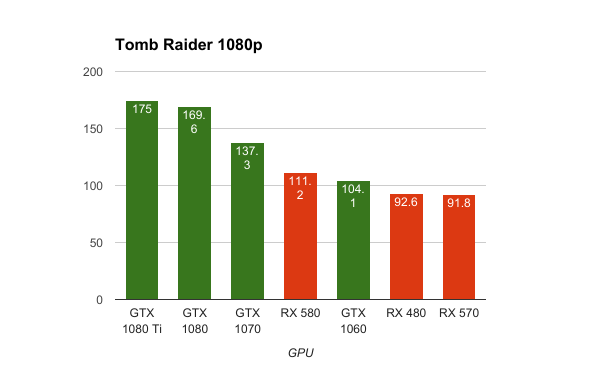
Tomb Raider is arguably the least graphically demanding game in our suite. Sapphire's RX 580 beats Nvidia's reference GTX 1060 by 6.8 percent here. The RX 480 and RX 570 also end up in a statistical tie, coming within one frame of each other.
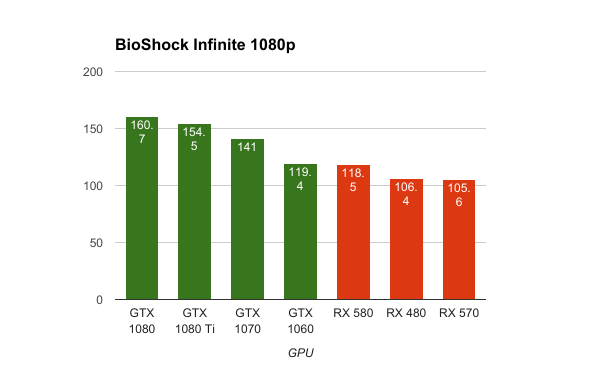
BioShock Infinite is roughly as graphically demanding as Tomb Raider, and here, Sapphire's RX 580 and Nvidia's reference GTX 1060 end up in a statistical tie. The RX 570 and RX 480 also end up in a statistical tie.
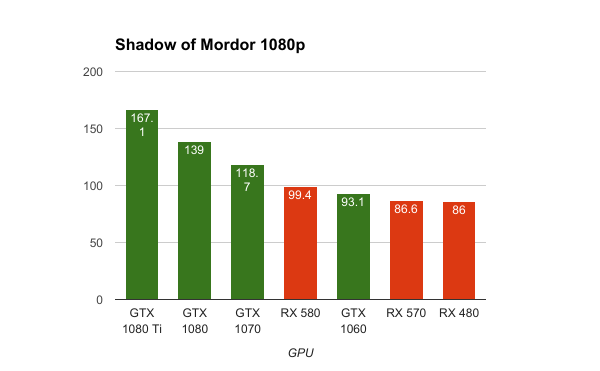
Shadow of Mordor is a moderately graphically demanding game. Here, the RX 580 beats the GTX 1060 by 6.7 percent. The RX 570 and RX 480 once again end up in a statistical tie.
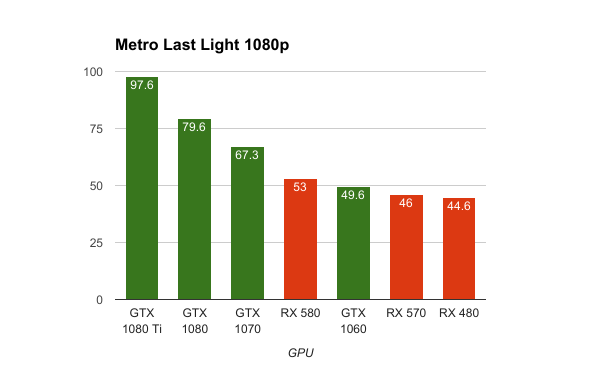
Metro Last Light is the most graphically demanding benchmark in our suite of tests. Here, the RX 580 beats the GTX 1060. The RX 570 also narrowly edges out the RX 480 with a three percent advantage.
1080p Benchmark Conclusion
Both the RX 580 and RX 570 make fantastic graphics cards for 1080p gaming. Aside from the most graphically demanding titles, they will run games above 60 FPS on average. This also makes them great GPUs for high refresh rate panels.
1440p Benchmarks
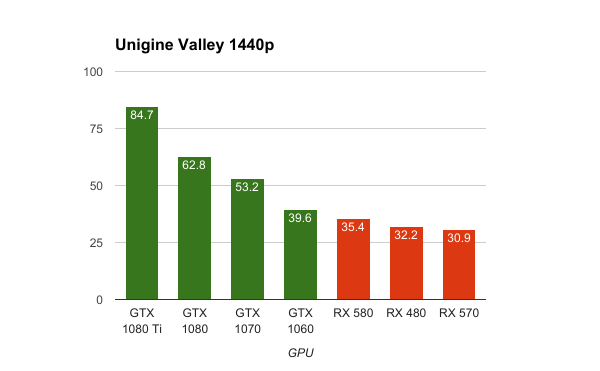
Cranking the resolution up to 1440p, the performance spread in Unigine Valley looks very similar to how it looked at 1080p. All of AMD's cards here manage to get above the 30 average FPS threshold, but they skirt the line pretty close, making frame rate dips a concern.
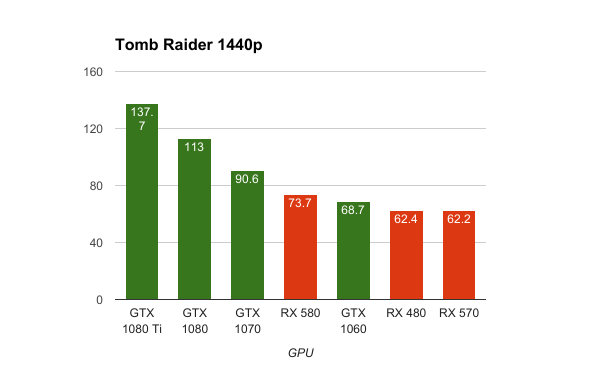
Echoing what we saw in the benchmark above, increasing the resolution to 1440p in Tomb Raider keeps the spread looking very similar to how it looked at 1080p. The RX 580 continues to best the GTX 1060. Meanwhile, the RX 480 and RX 570 end up in a statistical tie. All of the cards are able to get over 60 average FPS, which is great.
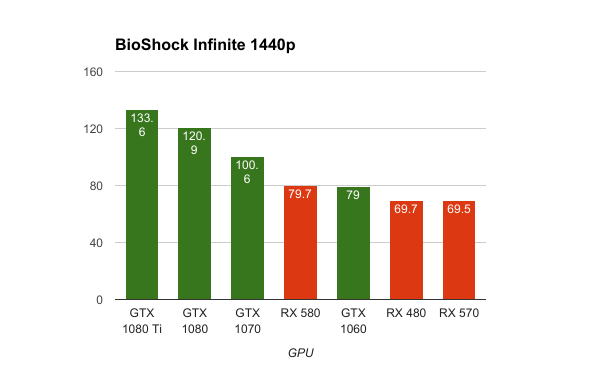
The RX 580 and GTX 1060 end up in a statistical tie in BioShock Infinite at 1440p, and so do the RX 480 and RX 570 GPUs. All of the cards are able to get over 60 average FPS.
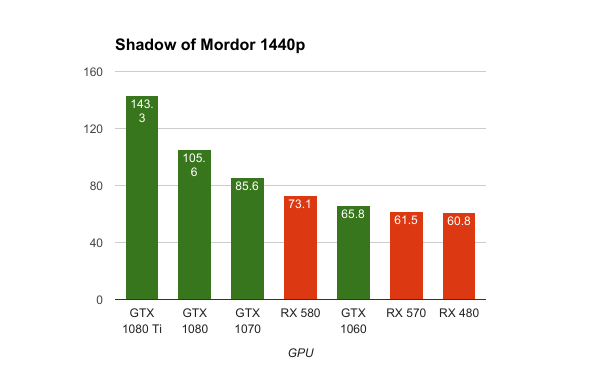
Like its 1080p counterpart, the spread continues to look the same at 1440p in Shadow of Mordor. All of the cards are able to run above 60 average FPS here.
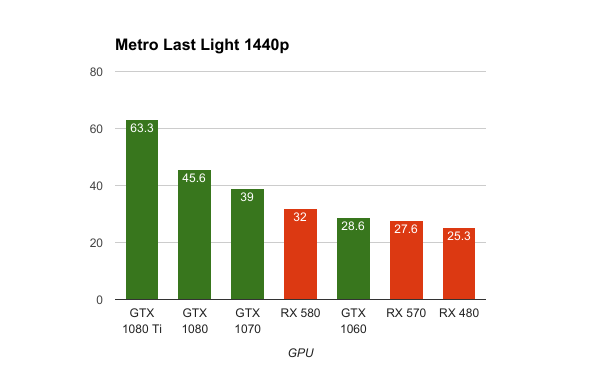
Metro Last Light at 1440p is the benchmark to really separate the wheat from the chaff. While the RX 580 is technically able to get above the 30 average FPS threshold, it does reach a low of 21.7. This indicates that you should either run the game at a lower resolution or turn some settings down. The GTX 1060, RX 570, and RX 480 all fail to meet the 30 average FPS threshold.
1440p Benchmark Conclusion
The RX 580 and RX 570 will be able to run most games at 1440p with playable frame rates. You will most likely want to turn some settings down in the more graphically demanding games, however.
4K Benchmarks
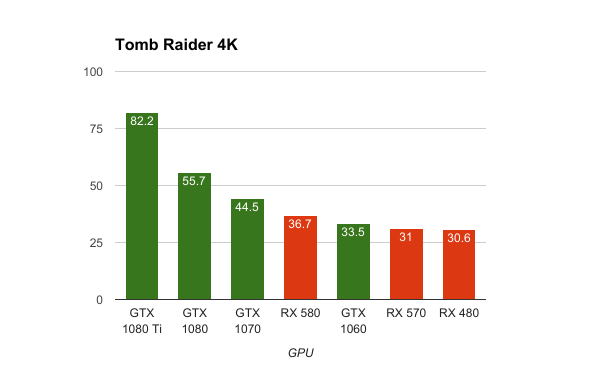
While all the cards here are able to get above 30 average FPS, anything slower than the RX 580 isn't advisable at these settings. The GTX 1060, RX 570, and RX 480 all occasionally dip below 30 FPS in Tomb Raider at 4K.
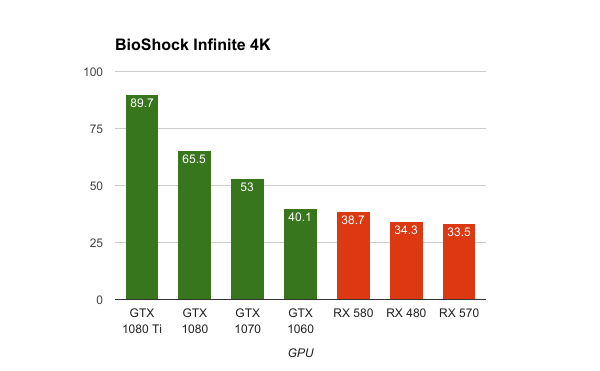
At 4K, the GTX 1060 narrowly outperforms the RX 580 by three percent. At these modest frame rates, every little bit helps. The RX 480 and the RX 570 end up in a statistical tie, with both cards producing average frame rates in the low 30s. You'll most likely want to tweak some settings to get better performance.
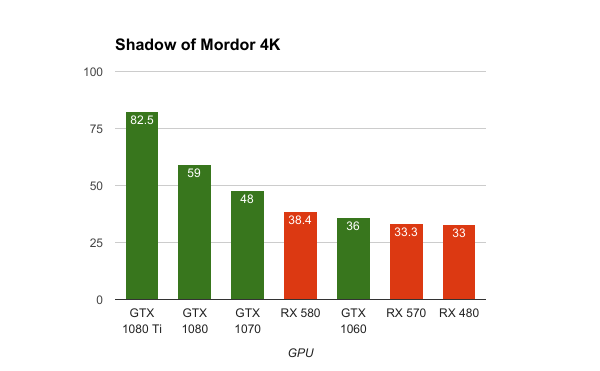
All of the cards here are able to muster above 30 average FPS performance, but again, you'll probably want to turn some settings down with anything slower than the GTX 1070. The RX 580 is six percent faster than the GTX 1060 here, and the RX 570 and RX 480 end up in a statistical tie.
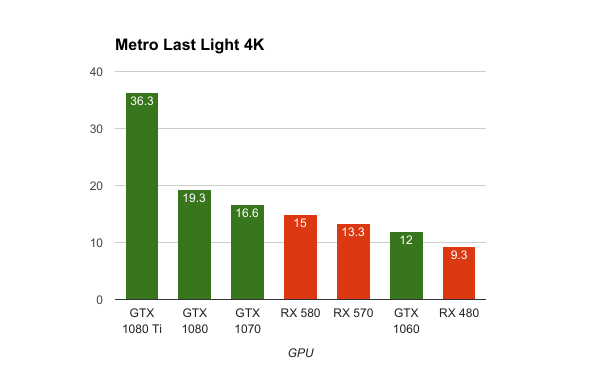
While the RX 580 and RX 570 beat the GTX 1060 in the Metro Last Light 4K benchmark, only the GTX 1080 Ti can make any playability claims here. Metro Last Light shows that the RX 580 and RX 570 won't be able to max out the most graphically demanding games at 4K.
4K Benchmark Conclusion
While both the RX 580 and RX 570 will be able to get over 30 average FPS in many games at 4K, they skirt the line so closely that you're better off running the game at lower resolutions to get smoother, more consistent gameplay. Really graphically demanding games like Metro Last Light will crush both cards at 2160p.
VR Benchmark
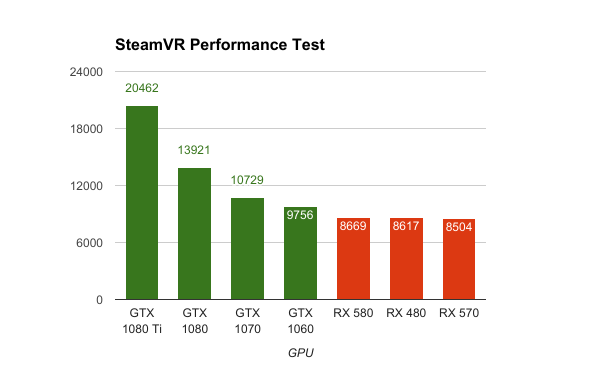
While the GTX 1060 and RX 580 have traded blows throughout my tests, the GTX 1060 definitively beats the RX 580 by 11 percent in Valve's SteamVR benchmark. The RX 580, RX 480 and RX 570 are all VR-capable cards and come within spitting distance of each other's performance.
Temperatures and Noise
The Sapphire RX 580 remained pretty quiet during all my tests. When I ran the Unigine Valley benchmark, the card recorded temps in the high 60 degrees Celsius, with the fans peaking out at around 1350 RPM.
The Asus Strix RX 570 hit similar temperatures that hovered around the mid 60 degrees C. While it never got uncomfortably loud, its fans did rev up a little higher with a 1560 RPM.
Conclusion
If you were hoping for top tier GPU performance from AMD that rivals Nvidia's best offerings, you’ll have to wait for AMD to release its Vega GPUs later this year. What we have here are budget-oriented cards that punch a bit above their price.
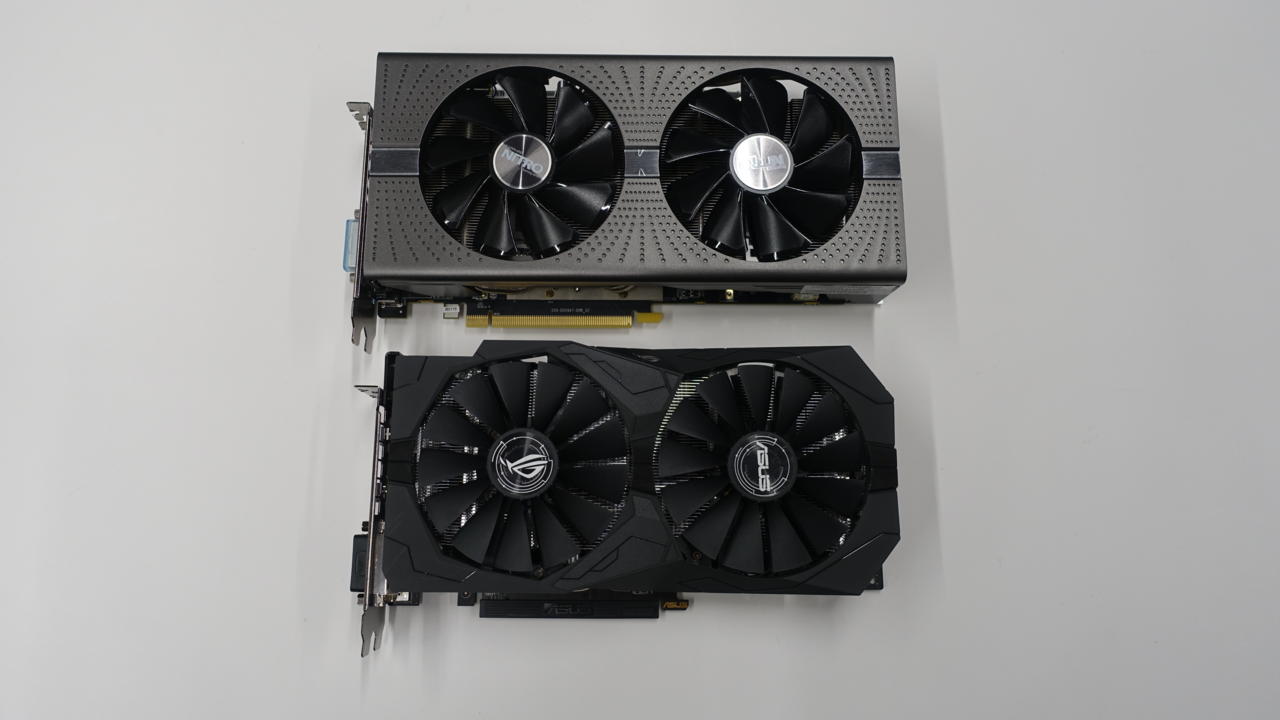
Sapphire's slightly overclocked RX 580 trades blows with Nvidia's slightly more expensive GTX 1060. According to our benchmark data, it's really too close to declare a definitive winner. One downside to the RX 580 is that it consumes a lot of power for a mid-range card.
When you take the average of our performance benchmarks, Sapphire's RX 580 is roughly 16 percent faster than Asus' RX 570, the latter of which performs neck and neck with AMD's reference RX 480 before it.
Neither the RX 580 or RX 570 offer huge performance jumps over their respective predecessors, but they're still compelling GPUs for those who want to game at 1080p and 1440p and don't want to break the bank getting there.














